OUTGOING WATERWAYS TO KIZILÇULLU AQUEDUCTS AND WATER MILLS
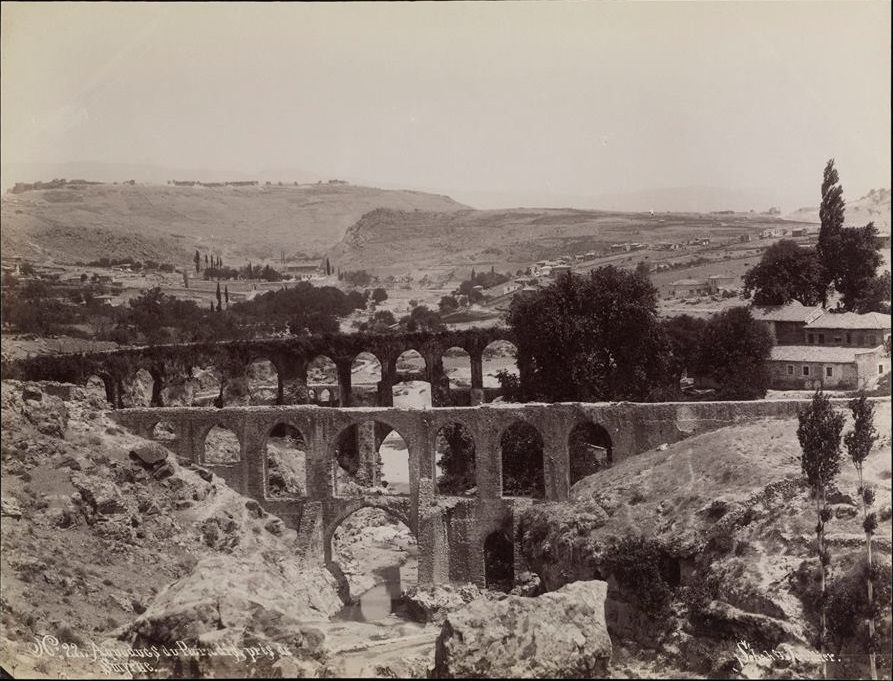
- Waterways leading to Kızılçullu aqueducts -
German researcher Georg Weber talks about the waterways in Buca in detail in his book published in 1900 and also gives information about the waterways leading to the Kızılçullu aqueducts. According to Weber, not only the Meles Stream but also the waters from the Buca Plain reach the Kızılçullu aqueducts.
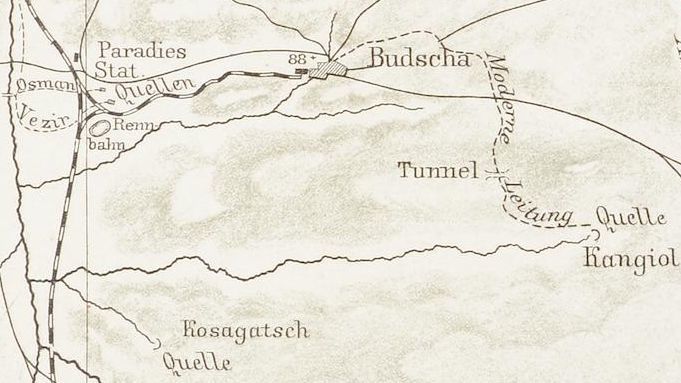 Buca ve civarındaki su yolları, Weber, 1899The first waterway is the Osman Ağa spring, which originates from the south of Şirinyer train station, where Şirinyer Park is today. Osman Ağa spring also gave its name to the aqueducts of that period. In his book, Weber refers to the aqueducts as Osmanağa aqueducts. Osman Ağa water originates from the land that belonged to a Turk at that time, and passes through the place known as NATO land today, which belonged to the Armenian Ispartaliyan family at that time, and reaches the three-storey aqueduct. According to historian Yaşar Ürük, Hacı Osman Ağa, who is said to be the steward or steward of Fazıl Ahmet Pasha, connected the water coming from Kızılçullu to the fountains in 1656, allowing these waters to flow in İzmir. For this reason, during the Ottoman Period and the first years of the republic, the spring water was referred to as Osman Ağa water. It is stated in various sources that Hacı Osman Ağa also had an aqueduct built on Yeşildere (it is unclear whether he means the Vezirsuyu aqueduct) in order to ensure that this water passes across Yeşildere. Yaşar Ürük adds some more information about the Osman Ağa source. Osman Ağa water comes out of a field near Şirinyer station (where Şirinyer Park is located) and flows on its own through earthen pipes (pipes) without requiring pumping. At that time, there was a large ground current beneath the source. This spring water goes to Tamaşalık, covered by arches and channels above ground, and from there it is distributed to the city of Izmir. Osman Ağa waterway, together with Vezirsuyu, was repaired in 1857 and 1917. In 1914, the project for pouring water through iron pipes was prepared. However, this project was completed only in 1938.
Buca ve civarındaki su yolları, Weber, 1899The first waterway is the Osman Ağa spring, which originates from the south of Şirinyer train station, where Şirinyer Park is today. Osman Ağa spring also gave its name to the aqueducts of that period. In his book, Weber refers to the aqueducts as Osmanağa aqueducts. Osman Ağa water originates from the land that belonged to a Turk at that time, and passes through the place known as NATO land today, which belonged to the Armenian Ispartaliyan family at that time, and reaches the three-storey aqueduct. According to historian Yaşar Ürük, Hacı Osman Ağa, who is said to be the steward or steward of Fazıl Ahmet Pasha, connected the water coming from Kızılçullu to the fountains in 1656, allowing these waters to flow in İzmir. For this reason, during the Ottoman Period and the first years of the republic, the spring water was referred to as Osman Ağa water. It is stated in various sources that Hacı Osman Ağa also had an aqueduct built on Yeşildere (it is unclear whether he means the Vezirsuyu aqueduct) in order to ensure that this water passes across Yeşildere. Yaşar Ürük adds some more information about the Osman Ağa source. Osman Ağa water comes out of a field near Şirinyer station (where Şirinyer Park is located) and flows on its own through earthen pipes (pipes) without requiring pumping. At that time, there was a large ground current beneath the source. This spring water goes to Tamaşalık, covered by arches and channels above ground, and from there it is distributed to the city of Izmir. Osman Ağa waterway, together with Vezirsuyu, was repaired in 1857 and 1917. In 1914, the project for pouring water through iron pipes was prepared. However, this project was completed only in 1938.
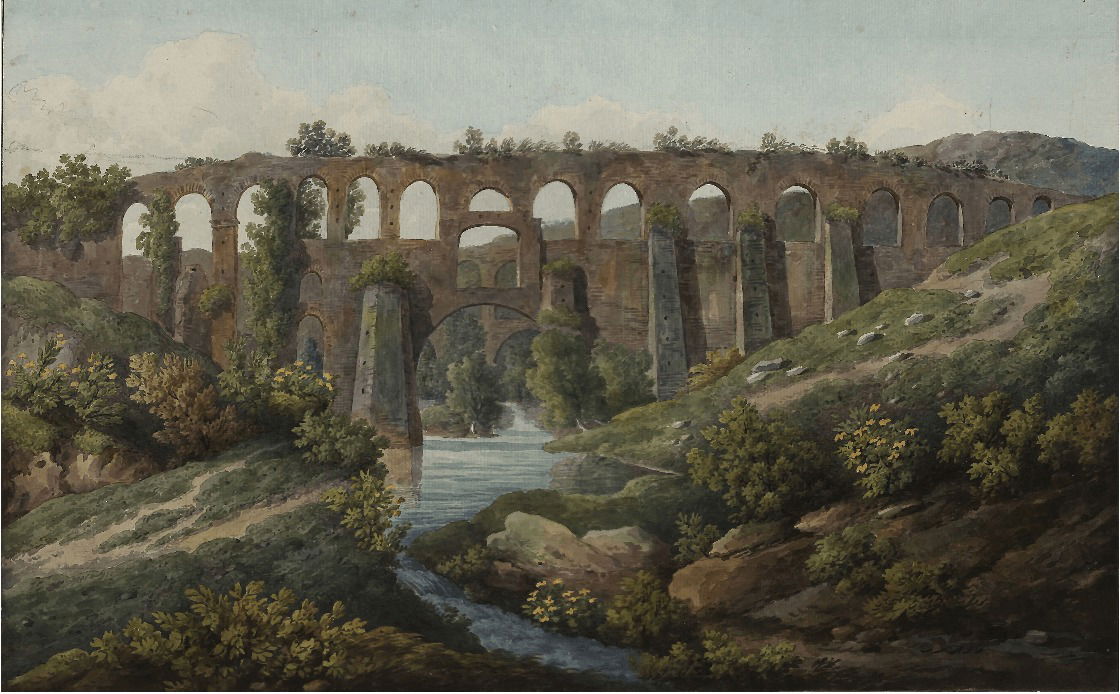 Kızılçullu su kemerleri, 1794-1796 yılları (Fotoğraf: Morritt Family Trusts)Another source is mentioned further south of the Osman Ağa water. This source is named Vezirsuyu. Like the Osmanağa spring, it was rising from Kızılçullu, a little further south of the Osmanağa spring. It is seen that it was carried northward through pipes before reaching the Kızılçullu aqueducts from its source. According to Yaşar Ürük, Vezirsuyu was one of the two most important water sources carrying water to Izmir before the Halkapınar facilities dried up. Izmir began to suffer from water shortage due to population growth since the 17th century. Thereupon, Grand Vizier Fazıl Ahmet Pasha took action and built a large aqueduct over Yeşildere in 1674 in order to bring the "vizier" spring, whose source was in Kızılçullu and which would be named in his memory, to Izmir. By passing the Vezirsuyu across the stream via the aqueduct, he enabled the spring water to reach Izmir. This spring water was supplied from three separate sources and reached the Selvili Mescit in the city center through closed channels above ground.
Kızılçullu su kemerleri, 1794-1796 yılları (Fotoğraf: Morritt Family Trusts)Another source is mentioned further south of the Osman Ağa water. This source is named Vezirsuyu. Like the Osmanağa spring, it was rising from Kızılçullu, a little further south of the Osmanağa spring. It is seen that it was carried northward through pipes before reaching the Kızılçullu aqueducts from its source. According to Yaşar Ürük, Vezirsuyu was one of the two most important water sources carrying water to Izmir before the Halkapınar facilities dried up. Izmir began to suffer from water shortage due to population growth since the 17th century. Thereupon, Grand Vizier Fazıl Ahmet Pasha took action and built a large aqueduct over Yeşildere in 1674 in order to bring the "vizier" spring, whose source was in Kızılçullu and which would be named in his memory, to Izmir. By passing the Vezirsuyu across the stream via the aqueduct, he enabled the spring water to reach Izmir. This spring water was supplied from three separate sources and reached the Selvili Mescit in the city center through closed channels above ground.
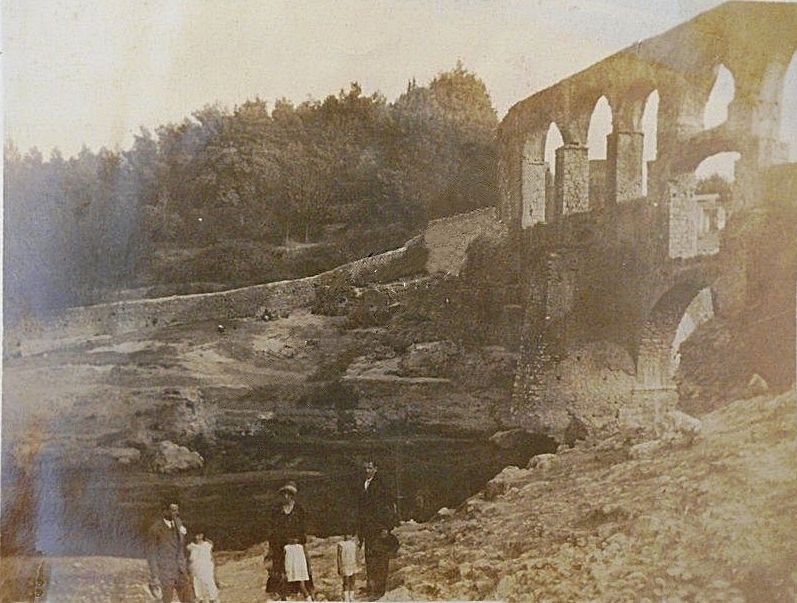 Su kemerlerinin muhtemelen 1930'larda çekilmiş bir fotoğrafıThe third and largest stream reaching the Kızılçullu aqueducts is Meles Stream. Meles Stream encounters at least two obstacles before reaching the Kızılçullu aqueducts, and Meles water is directed to the part where the water mills are located, through a road opened from the right side, and the water is used by the water mills. The remaining majority of Meles Stream flows down from the waterfall-like height behind the two-storey aqueduct and heads towards the Gulf of Izmir.
Su kemerlerinin muhtemelen 1930'larda çekilmiş bir fotoğrafıThe third and largest stream reaching the Kızılçullu aqueducts is Meles Stream. Meles Stream encounters at least two obstacles before reaching the Kızılçullu aqueducts, and Meles water is directed to the part where the water mills are located, through a road opened from the right side, and the water is used by the water mills. The remaining majority of Meles Stream flows down from the waterfall-like height behind the two-storey aqueduct and heads towards the Gulf of Izmir.
Finally, it should be added that the three-storey Kızılçullu aqueduct has a history of more than a thousand years and the information we have available covers the Ottoman Period. It is impossible to go further than guessing where water was supplied to the Kızılçullu aqueducts in the times before the Ottoman Period. Some historians think that water may have been delivered to the aqueducts from the Resources and Kozağaç direction. However, considering that the population and therefore the need for water was less at that time, it can be said that the aqueducts were most likely supplied from the Kızılçullu plains during the Byzantine Period. At that time, the settlement in Izmir consisted largely of Kadifekale, and it seems unlikely that water was brought from much longer points.
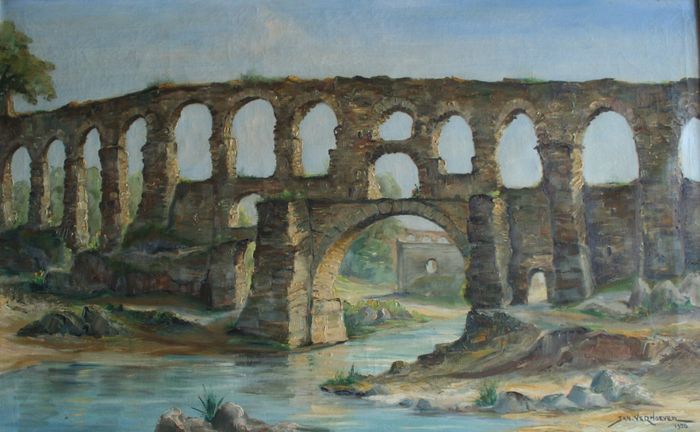 Flemenk ressam Jan Verhoeven tarafından 1956 yılında yapılmış bir Kızılçullu su kemerleri tablosu
Flemenk ressam Jan Verhoeven tarafından 1956 yılında yapılmış bir Kızılçullu su kemerleri tablosu
- Operation of Kızılçullu mills -
Thanks to the research of Georg Weber, it can be seen that the Kızılçullu aqueducts were used not only in the Roman and Byzantine periods, but also until the beginning of the last century. By drawing the Kızılçullu aqueducts, Georg Weber reveals that the aqueducts carried water to Izmir and that the water mills near the aqueducts were fed not only by the water coming from the Meles Stream, but also by the water coming from Kızılçullu.
 Kızılçullu su kemerlerinin işleyişini gösteren taslak, Georg Weber, 1899It is understood that Osman Ağa water originates from the area where Şirinyer Park is located today and was probably brought to the aqueducts through pipes. According to Weber, the water brought from land belonging to a Turk was passed through the American College land, which had not yet been built at that time, and reached the three-storey Roman-era aqueduct. Contrary to popular belief, it was not crossed via aqueducts at that time. In fact, the reason why the second aqueduct was built in the Ottoman Period was that the first aqueduct had lost its function. Osman Ağa water, which comes all the way here, first reaches the water mills on the hill. Then it goes down and reaches the water mill in the valley. Some of the Osman Ağa water reaches the water channel coming from Meles Stream before reaching the second mill.
Kızılçullu su kemerlerinin işleyişini gösteren taslak, Georg Weber, 1899It is understood that Osman Ağa water originates from the area where Şirinyer Park is located today and was probably brought to the aqueducts through pipes. According to Weber, the water brought from land belonging to a Turk was passed through the American College land, which had not yet been built at that time, and reached the three-storey Roman-era aqueduct. Contrary to popular belief, it was not crossed via aqueducts at that time. In fact, the reason why the second aqueduct was built in the Ottoman Period was that the first aqueduct had lost its function. Osman Ağa water, which comes all the way here, first reaches the water mills on the hill. Then it goes down and reaches the water mill in the valley. Some of the Osman Ağa water reaches the water channel coming from Meles Stream before reaching the second mill.
The second spring, called Vezirsuyu and coming from Kızılçullu, originates slightly below the Osmanağa spring and continues parallel to the Kızılçullu-Buca railway line, then is directed towards Yeşildere before reaching Meles Stream. When it reaches Yeşildere Valley, it is passed across through pipes from one or more points and directed towards the city of Izmir. Vezirsuyu source should not be confused with Karapınar water, which provides water to the Vezirsuyu aqueducts in Yeşildere. It is known that in the past, both waterways were directed to Izmir via the Vezirağa aqueducts.
Apart from the two waterways coming from the direction of Buca, an artificial waterway coming from the Meles Stream also attracts attention. A part of the Meles Stream, whose path is divided by an artificial barrier before reaching the two-storey Ottoman period aqueduct, is transferred to the artificial waterway and passes in front of the water mill on the east side of the aqueduct. It is estimated that it was also used by the water wheel here. After passing in front of the mill, the water passes under the three-storey aqueduct and continues towards Yeşildere.
It is not known who owns the water mills on the eastern side of the Kızılçullu aqueducts, but there is a strong possibility that they belong to a local Greek in the region. Although the Greek population in the region is higher than the Turks, Bucalı Hacıandoniyadis also has a tower near the Prophet Elijah Monastery. In addition, it is known that the land on which the American College was built previously belonged to the non-Muslim Ispartalian family. Water mills are also present on a map dated 1780, which suggests that the mills date back to much earlier times. As mentioned before, the water mill above uses Osman Ağa water. The water mill below has a water wheel. The water wheel benefits from the artificial canal opened here to use the water of the Meles Stream. The water mill below benefits from both Osman Ağa water and Meles Stream.
It appears that both aqueducts have not been used to transport water since the early 1800s. There is no information about when the use of the second two-storey Ottoman period aqueduct was abandoned.
- Additions - Kızılçullu su kemerlerine ulaşan su yolları ve su değirmenlerinin günümüzdeki yerleri
Kızılçullu su kemerlerine ulaşan su yolları ve su değirmenlerinin günümüzdeki yerleri
This article was created by atalarimizintopraklari.com. All rights reserved. All or part of this article cannot be used in books, magazines or newspapers without citing the source.
- Sources -
kentyasam.com/izmirde-vezir-ve-pasa-adlari-yhbrdty-4042.html
İzmir Dergisi, 35'nci sayı, Akın Ersoy-Sarp Alatepeli
Wasserleitungen von Smyrna, Georg Weber, 1899
Buca, Nikos Kararas, 1962